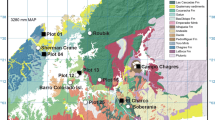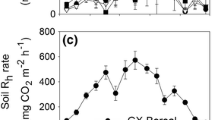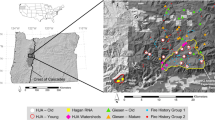Abstract
Soil microbes mediate major biogeochemical processes in forest ecosystems. Soil pH is considered a “master variable” with a strong positive effect on many biogeochemical processes. To better understand how soil pH influences microbial activity and nitrogen (N) dynamics in forests, we utilized a set of long-term measurements of surface soil pH, N availability, and microbial biomass and respiration from the Hubbard Brook Experimental Forest (HBEF), a northern hardwood forest in New Hampshire, USA. We compared the strengths of these relationships in an unmanipulated watershed, where naturally acidic soils have been further acidified by anthropogenic acid deposition, to those in a nearby watershed, where soils were treated with calcium silicate to ameliorate the effects of acid deposition. While we expected to observe strong positive relationships between soil pH and microbial biomass and activity, we instead found weak and/or curvilinear relationships. In many cases, microbial biomass and activity peaked at unexpectedly low pH values (~ 4.5), and decreased at higher pH values, especially in the calcium-treated soils. It is likely that complexities in plant-microbial interactions inhibit and/or mask microbial response to changes in pH in these acidic soils. These results raise questions about pH as a controller of microbial processes and how ecosystems recover in response to decreases in acid deposition.





Similar content being viewed by others
Data availability
Data are available at: https://portal.edirepository.org/nis/mapbrowse?scope=knb-lter-hbr&identifier=252.
References
Bahram M, Hildebrand F, Forslund SK, Anderson JL, Soudzilovskaia NA, Bodegom PM, Bengtsson-Palme J, Anslan S, Coelho LP, Harend H, Huerta-Cepas J, Medema MH, Maltz MR, Mundra S, Olsson PA, Pent M, Põlme S, Sunagawa S, Ryberg M, Tedersoo L, Bork P (2018) Structure and function of the global topsoil microbiome. Nature 560(7717):233–237
Bardgett RD, van der Putten WH (2014) Belowground biodiversity and ecosystem functioning. Nature 515(7528):505–511
Battles JJ, Fahey TJ, Driscoll CT Jr, Blum JD, Johnson CE (2014) Restoring soil calcium reverses forest decline. Environ Sci Technol Lett 1(1):15–19
Bohlen PJ, Groffman PM, Driscoll CT, Fahey TJ, Siccama TG (2001) Plant-soil-microbial interactions in a northern hardwood forest. Ecology 82(4):965–978
Campbell JL, Rustad LE, Bailey SW, Bernhardt ES, Driscoll CT, Green MB, Groffman PM, Lovett GM, McDowell WH, McGuire KJ, Rosi EJ (2021) Watershed studies at the Hubbard Brook Experimental Forest: building on a long legacy of research with new approaches and sources of data. Hydrol Process 35(1):e14016
Cho Y, Driscoll C, Johnson C, Siccama T (2010) Chemical changes in soil and soil solution after calcium silicate addition to a northern hardwood forest. Biogeochemistry 100(1):3–20
Cho Y, Driscoll CT, Johnson CE, Blum JD, Fahey TJ (2012) Watershed-level responses to calcium silicate treatment in a northern hardwood forest. Ecosystems 15(3):416–434
Coleman DC, Callaham MA, Crossley DA Jr (2017) Fundamentals of soil ecology, 3rd edn. Elsevier Academic Press, Oxford
Delgado-Baquerizo M, Oliverio AM, Brewer TE, Benavent-González A, Eldridge DJ, Bardgett RD, Maestre FT, Singh BK, Fierer N (2018) A global atlas of the dominant bacteria found in soil. Science 359(6373):320–325
Drake JE, Gallet-Budynek A, Hofmockel KS, Bernhardt ES, Billings SA, Jackson RB, Johnsen KS, Lichter J, McCarthy HR, McCormack ML, Moore DJP, Oren R, Palmroth S, Phillips RP, Pippen JS, Pritchard SG, Treseder KK, Schlesinger WH, DeLucia EH, Finzi AC (2011) Increases in the flux of carbon belowground stimulate nitrogen uptake and sustain the long-term enhancement of forest productivity under elevated CO2. Ecol Lett 14(4):349–357
Driscoll CT, Lawrence GB, Bulger AJ, Butler TJ, Cronan CS, Eagar C, Lambert KF, Likens GE, Stoddard JL, Weathers KC (2001) Acidic deposition in the northeastern United States: sources and inputs, ecosystem effects, and management strategies. Bioscience 51(3):180–198
Fierer N, Strickland MS, Liptzin D, Bradford MA, Cleveland CC (2009) Global patterns in belowground communities. Ecol Lett 12(11):1238–1249
Fiorentino I, Fahey TJ, Groffman PM, Driscoll CT, Eagar C, Siccama TG (2003) Initial responses of phosphorus biogeochemistry to calcium addition in a northern hardwood forest ecosystem. Can J for Res 33(10):1864–1873
Gadgil RL, Gadgil P (1971) Mycorrhiza and litter decomposition. Nature 233(5315):133–133
Garcia MO, Templer PH, Sorensen PO, Sanders-DeMott R, Groffman PM, Bhatnagar JM (2020) Soil microbes trade-off biogeochemical cycling for stress tolerance traits in response to year-round climate change. Front Microbiol 11:616
Groffman PM, Fisk MC (2011a) Calcium constrains plant control over forest ecosystem nitrogen cycling. Ecology 92:2035–2042
Groffman PM, Fisk MC (2011b) Phosphate additions have no effect on microbial biomass and activity in a northern hardwood forest. Soil Biol Biochem 43:2441–2449
Groffman PM, Holland EA, Myrold DD, Robertson GP, Zou X (1999) Denitrification. In: Robertson GP, Bledsoe CS, Coleman DC, Sollins P (eds) Standard soil methods for long term ecological research. Oxford University Press, New York, pp 272–288
Groffman PM, Fisk MC, Driscoll CT, Likens GE, Fahey TJ, Eagar C, Pardo LH (2006) Calcium additions and microbial nitrogen cycle processes in a northern hardwood forest. Ecosystems 9(8):1289–1305
Groffman PM, Discoll CT, Duran J, Campbell JL, Christenson LM, Fahey TJ, Fisk MC, Fuss C, Likens GE, Lovett GM, Rustad L, Templer P (2018) Nitrogen oligotrophication in northern hardwood forests. Biogeochemistry 141:123–129
Groffman PM (2019) Long-term measurements of microbial biomass and activity at the Hubbard Brook Experimental Forest, 1994—present. In Environmental data initiative. https://doi.org/10.6073/pasta/2a0482218fa34bs667e501c8cc48f8be8. Dataset accessed 01/31/2022.
Hartman WH, Richardson CJ, Vilgalys R, Bruland GL (2008) Environmental and anthropogenic controls over bacterial communities in wetland soils. Proc Natl Acad Sci 105(46):17842–17847
Haynes W (2013) Bonferroni correction. In: Dubitzky W, Wolkenhauer O, Cho K-H, Yokota H (eds) Encyclopedia of systems biology. Springer, New York, pp 154–154
Jandl R, Smidt S, Mutsch F, Fürst A, Zechmeister H, Bauer H, Dirnböck T (2012) Acidification and nitrogen eutrophication of Austrian forest soils. Appl Environ Soil Sci 2012:632602
Jenkinson DS, Powlson DS (1976) The effects of biocidal treatments on metabolism in soil V: a method for measuring soil biomass. Soil Biol Biochem 8:209–213
Johnson CE, Driscoll CT, Siccama TG, Likens GE (2000) Element fluxes and landscape position in a northern hardwood forest watershed ecosystem. Ecosystems 3(2):159–184
Johnson CE, Driscoll CT, Blum JD, Fahey TJ, Battles JJ (2014) Soil chemical dynamics after calcium silicate addition to a northern hardwood forest. Soil Sci Soc Am J 78(4):1458–1468
Juice SM, Fahey TJ, Siccama TG, Driscoll CT, Denny EG, Eagar C, Cleavitt NL, Minocha R, Richardson AD (2006) Response of sugar maple to calcium addition to northern hardwood forest. Ecology 87(5):1267–1280
Kuzyakov Y, Blagodatskaya E (2015) Microbial hotspots and hot moments in soil: concept & review. Soil Biol Biochem 83:184–199
Lauber CL, Hamady M, Knight R, Fierer N (2009) Pyrosequencing-based assessment of soil pH as a predictor of soil bacterial community structure at the continental scale. Appl Environ Microbiol 75(15):5111–5120
Lawrence GB, David MB, Shortle WC (1995) A new mechanism for calcium loss in forest-floor soils. Nature 378(6553):162–165
Likens GE, Driscoll CT, Buso DC (1996) Long-term effects of acid rain: response and recovery of a forest ecosystem. Science 272(5259):244–246
Likens GE, Driscoll CT, Buso DC, Siccama TG, Johnson CE, Lovett GM, Fahey TJ, Reiners WA, Ryan DF, Martin CW, Bailey SW (1998) The biogeochemistry of calcium at Hubbard Brook. Biogeochemistry 41(2):89–173
Likens GE, Buso DC, Bernhardt ES, Rosi E (2021) A century of change: reconstructing the biogeochemical history of Hubbard Brook. Hydrol Process 35(6):e14256
McInnes KJ, Weaver RW, Savage MJ (1994) Soil water potential. In: Weaver RW (ed) Methods of soil analysis, part 2—microbiological and biochemical properties. Soil Science Society of America, Madison, pp 53–58
Meng C, Tian D, Zeng H, Li Z, Yi C, Niu S (2019) Global soil acidification impacts on belowground processes. Environ Res Lett 14(7):074003
Nicol GW, Leininger S, Schleper C, Prosser JI (2008) The influence of soil pH on the diversity, abundance and transcriptional activity of ammonia oxidizing archaea and bacteria. Environ Microbiol 10(11):2966–2978
Oulehle F, Evans CD, Hofmeister J, Krejci R, Tahovska K, Persson T, Cudlin P, Hruska J (2011) Major changes in forest carbon and nitrogen cycling caused by declining sulphur deposition. Glob Change Biol 17(10):3115–3129
Oulehle F, Chuman T, Hruška J, Krám P, McDowell WH, Myška O, Navrátil T, Tesař M (2017) Recovery from acidification alters concentrations and fluxes of solutes from Czech catchments. Biogeochemistry 132(3):251–272
Palmer SM, Driscoll CT, Johnson CE (2004) Long-term trends in soil solution and stream water chemistry at the Hubbard Brook Experimental Forest: relationship with landscape position. Biogeochemistry 68(1):51–70
Paul EA (ed) (2014) Soil microbiology, ecology, and biochemistry, 4th edn. Academic Press, Amsterdam
Payne WJ (1981) Denitrification. Wiley, New Yrok
R Core Team (2021) R: a language and environment for statistical computing. R Foundation for Statistical Computing, Vienna
Roco CA, Dörsch P, Booth JG, Pepe-Ranney C, Groffman PM, Fahey TJ, Yavitt JB, Shapleigh JP (2019) Using metagenomics to reveal landscape scale patterns of denitrifiers in a montane forest ecosystem. Soil Biol Biochem 138:107585
Rosi-Marshall EJ, Bernhardt ES, Buso DC, Driscoll CT, Likens GE (2016) Acid rain mitigation experiment shifts a forested watershed from a net sink to a net source of nitrogen. Proc Natl Acad Sci 113(27):7580–7583
Smith MS, Tiedje JM (1979) Phases of denitrification following oxygen depletion in soil. Soil Biol Biochem 11:262–267
Sorensen PO, Templer PH, Christenson L, Duran J, Fahey T, Fisk MC, Groffman PM, Morse JL, Finzi AC (2016) Reduced snow cover alters root-microbe interactions and decreases nitrification rates in a northern hardwood forest. Ecology 97(12):3359–3368
Sorensen PO, Bhatnagar JM, Christenson L, Duran J, Fahey T, Fisk MC, Finzi AC, Groffman PM, Morse JL, Templer PH (2019) Roots mediate the effects of snowpack decline on soil bacteria, fungi, and nitrogen cycling in a northern hardwood forest. Front Microbiol. https://doi.org/10.3389/fmicb.2019.00926
Sridevi G, Minocha R, Turlapati SA, Goldfarb KC, Brodie EL, Tisa LS, Minocha SC (2012) Soil bacterial communities of a calcium-supplemented and a reference watershed at the Hubbard Brook Experimental Forest (HBEF), New Hampshire, USA. FEMS Microbiol Ecol 79(3):728–740
van Breemen N, Mulder J, Driscoll CT (1983) Acidification and alkalinization of soils. Plant Soil 75(3):283–308
Voroney RP, Paul EA (1984) Determination of kc and kn in situ for calibration of the chloroform fumigation-incubation method. Soil Biol Biochem 16:9–14
Wickham H (2016) ggplot2: elegant graphics for data analysis. Springer-Verlag, New York
Wickham H, François R (2022) dplyr: a grammar of data manipulation. https://dplyr.tidyverse.org, https://github.com/tidyverse/dplyr
Yao H, Gao Y, Nicol GW, Campbell CD, Prosser JI, Zhang L, Han W, Singh BK (2011) Links between ammonia oxidizer community structure, abundance, and nitrification potential in acidic soils. Appl Environ Microbiol 77(13):4618–4625
Zhalnina K, Dias R, de Quadros PD, Davis-Richardson A, Camargo FAO, Clark IM, McGrath SP, Hirsch PR, Triplett EW (2015) Soil pH determines microbial diversity and composition in the park grass experiment. Microb Ecol 69(2):395–406
Zumft WG (1997) Cell biology and molecular basis of denitrification. Microbiol Mol Biol Rev 61(4):533–616
Funding
This research was supported by a Grant from the U.S. National Science Foundation Long-Term Ecological Research Program (Award # 1637685). We thank Lisa Martel for help with field, laboratory and data analysis and Clare Kohler for help with statistical analysis and graphing.
Author information
Authors and Affiliations
Corresponding author
Ethics declarations
Conflict of interest
The authors have not disclosed any competing interests.
Additional information
Responsible Editor: Samantha R. Weintraub-Leff.
Publisher's Note
Springer Nature remains neutral with regard to jurisdictional claims in published maps and institutional affiliations.
Rights and permissions
Springer Nature or its licensor (e.g. a society or other partner) holds exclusive rights to this article under a publishing agreement with the author(s) or other rightsholder(s); author self-archiving of the accepted manuscript version of this article is solely governed by the terms of such publishing agreement and applicable law.
About this article
Cite this article
Ontman, R., Groffman, P.M., Driscoll, C.T. et al. Surprising relationships between soil pH and microbial biomass and activity in a northern hardwood forest. Biogeochemistry 163, 265–277 (2023). https://doi.org/10.1007/s10533-023-01031-0
Received:
Accepted:
Published:
Issue Date:
DOI: https://doi.org/10.1007/s10533-023-01031-0




